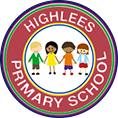Phonics at Highlees primary
At Highlees Primary, children begin to read in Reception using the synthetic Phonics scheme, DfE accredited, 'Little Wandle Letters and Sounds Revised'. Children concentrate on speaking and listening skills, preparing them for learning to read by developing their phonic knowledge and skills.
To start, children are immersed in activities which promote listening to environmental and instrumental sounds, body percussion, rhythm and rhyme, alliteration and voice sounds. They then begin oral segmenting and blending of familiar words, embedding their learning within language-rich provision and activities. Children then begin to distinguish between speech sounds and blend and segment words orally. They will learn the letter names (grapheme) and sound (phoneme) of each letter of the alphabet, then begin to represent each of 42 phonemes by a grapheme blending to read. Children then broaden their knowledge of graphemes and phonemes, learning alternative pronunciations. Children progress to read longer and less familiar texts independently and with increasing fluency.
Lots of opportunities should be provided for children to engage with books that fire their imagination and interest. Enjoying and sharing books leads to children seeing them as a source of pleasure and interest and motivates them to value reading.
Link to Little Wandle launch video
Why is phonics the best method for teaching children to read?
Phonics makes learning to read easier, simpler and crucially gets children reading quicker. This helps to increase a child's confidence and instil a love of reading from an early age. Rather than memorising 1,000's of words individually, children are instead taught phonics. A strong phonic knowledge helps children work out how to read 95% of the English language.
If you didn't learn to read using phonics it can seem very complicated, but once the concept of words being made up of just 44 sounds is understood, children are able to make remarkably quick progress in their reading.
What is phonics?
Each one of the 26 letters in the alphabet has its own ‘sound'. This is very different to how a letter is ‘said' in the alphabet. There are more than 26 sounds in the English language, in fact there are 44 sounds in total. Some of these sounds are made up of 2 or 3 letters. 2 letter sounds are called digraphs and three letter sounds are called trigraphs. It gets a bit more complicated than that too! For example the 'n' sound, like in 'nail' is also spelt ‘kn' like in ‘knot’ or ‘gn' like in ‘gnome’. The sound that children struggle to spot the most when breaking down words into its individual sounds is the 'split digraph'. Like a normal digraph, this is when two letters work together to make one sound, however with a split digraph, they are separated and have a letter in the middle. Fortunately, ‘split digraphs' always end with an ‘e' which does make them a little easier to spot!
You may hear your child talking about the following;
- Phoneme - a sound as it is said
- Grapheme - a sound that is written
- Digraph- two letters that work together to make the same sound
- Trigraph - Three letters that work together to make the same sound
- Split digraph - Two letters that work together to make the same sound, separated by another letter
How do we teach Phonics?
When do we teach phonics?
Our children are taught phonics every day in short sessions of 30 minutes; this supports consistency across the key stage and adopts a multi-sensory approach that ensures progress for all children. Once the children reach Year 1 they are supported through teaching in smaller guided groups that build on the phonics phase they are working within.
Activities to support Early Reading/Writing
At Highlees Primary we follow the ‘read, write, apply’ approach to phonics. The children learn a new sound daily; They are then given opportunities to read words that contain this sound, next they write words that contain the sound and to complete their lesson they apply what they have learned to an activity. This style of teaching is consistent across the school to ensure a good quality of teaching across the key stage.
What is the Phonics Screening Check?
The Phonics screening check is a compulsory assessment that all children in Year 1 in England must take. It is used to assess children’s phonic decoding skills. To pass, a pupil must correctly read around 32/40 words correctly. The 40 words in the check are split into sections progressing from simple word structures to trickier words with five or six letters.
The often confusing thing about the screening check is that 20/40 of the words that children are expected to read are ‘nonsense words’, alien words that have no meaning. This is so that the check tests a child’s ability to phonetically decode words and to ensure they don't just know the word in the check already. The aim of the check isn’t to test how many words a child can read, but to ensure children have the phonics skills they need to learn new words in the future.
The check is administered by your child’s teacher during the designated phonics screening week. The words are the same all across the country. Schools are sent the screening check through the post in a sealed box and teachers are not allowed to open the test until the start of that week. Your child will be scored against a national average which has been 32/40 since 2012. The mark will be told to schools at the end of June and results are shared with your Annual Report.
To find out more detail about the screening check click here
Useful Websites to develop phonics:
https://www.littlewandlelettersandsounds.org.uk/resources/for-parents/
https://www.phonicsplay.co.uk/resources
www.oxfordowl.co.uk - Learn to read with phonics: a parent guide
https://phonicsfamilycom.wordpress.com - A great website for fun family phonics games.
